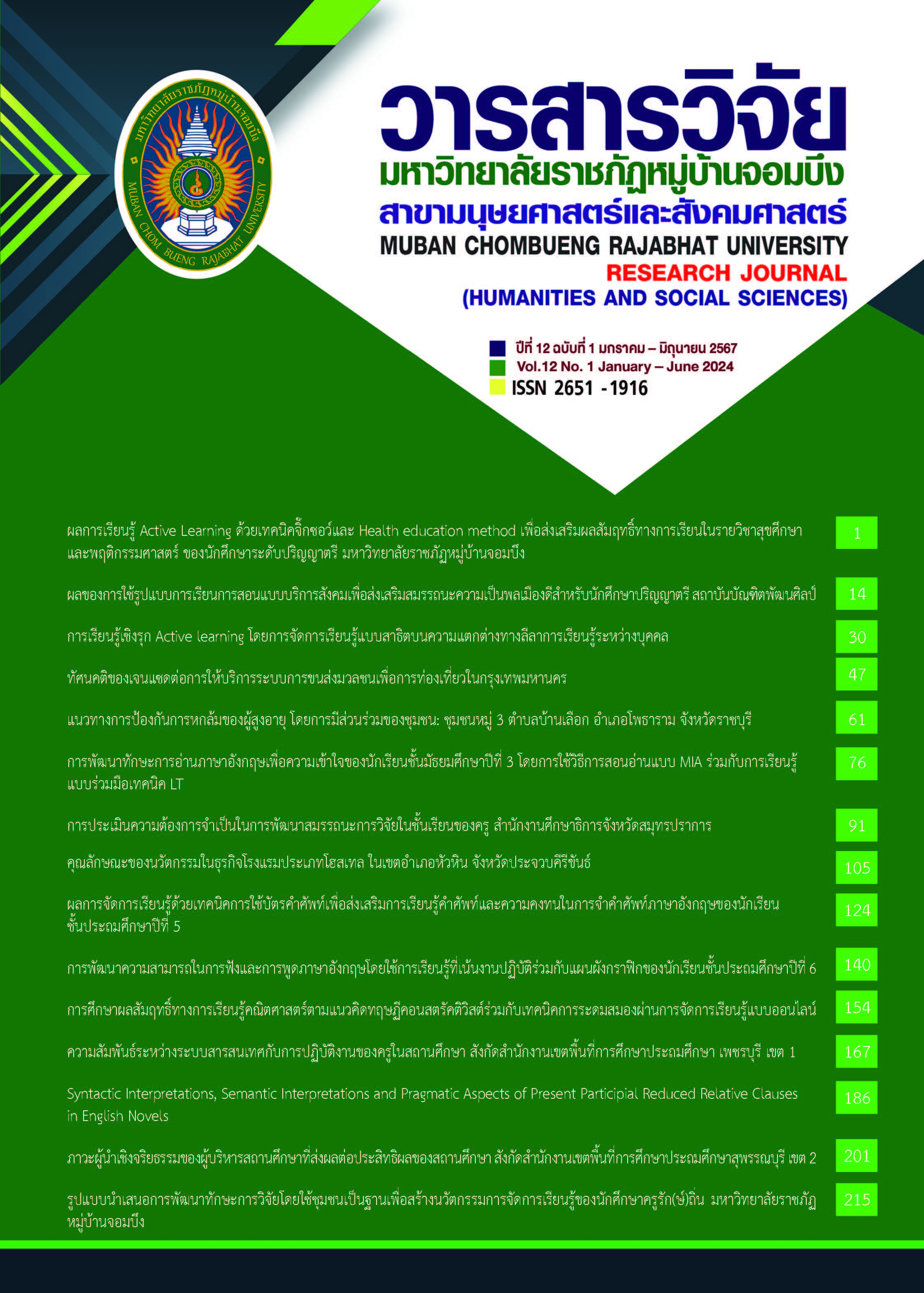Syntactic Interpretations, Semantic Interpretations and Pragmatic Aspects of Present Participial Reduced Relative Clauses in English Novels
Keywords:
syntactic interpretations, semantic interpretations, pragmatic aspects, present participial reduced relative clauses, English novelsAbstract
The objective of this study was to 1) examine syntactic interpretations, 2) examine semantic interpretations and 3) examine pragmatic aspects of present participial reduced relative clauses (PPRRC) in English novels. The samples in this study are the materials of English novels. The data collection was based upon a purposive sampling method where three best-seller American novels (amazon.com) were collected to study. The sample in this study is three English novels including The Lottery (Jackson, 2015), The Turn of the Screw (James, 2021) and On the Road (Kerouac, 2022). In regard to research methodology, the data collection was approximately 300,000 words containing a total of 20 tokens, referring to sentences. The data analysis of the syntactic theory of PPRRC follows Radford (2009), whereas the semantic interpretations in this study are based on Kearns’ (2011) aspectual classes of events. This study employs descriptive statistical analysis where frequencies were converted into percentages. The equipment to collect the data is Microsoft Excel.
The results of the study show that (1) the syntactic interpretations of PPRRCs are explained by the complexity principle. Using PPRRCs helps the writers reduce the workload of the brain in producing shorter sentences. (2) The semantic interpretations of PPRRCs are explained by the aspectual class of activity. This means that most aspectual of verbs in novels are activity and accomplishments as in the princess waking up at midnight to indicate the ending point. (3) In regard to pragmatic aspects, PPRRCs mostly occur in the final position to comply with the least effort of requirement. Longer sentences need to be made to read and understand the text.
References
Al-Momani, M. M. A. (2019). A study on the function of the English participial phrases. US-China Foreign Language, 17(2), 1-6.
Anastasova, M. (2017). A contrastive analysis of the English past participle and the Bulgarian past Participle. Language and Literature, 55(1). 136-146
Basetlíková, J. (2012). Present participle in the English and Czech fiction. Retrieved on October 22, 2022 from https://dk.upce.cz/bitstream/handle/10195/45759/Basetl%C3%ADkov%C3%A1J_Presentparticiple_LH_2012.pdf.pdf?sequence=3&isAllowed=y
Childs, L. G. (1997). Present Participle Adjuncts in the Book of Mormon. Journal of Book of Mormon Studies, 6(1), 24-38.
Jackson, H. (2015). The lottery. UK: Penguin Random House.
James, H. (2021). The turn of the screw. UK: Penguin Random House.
Haryani, E., & Fatimah, S. (2020). An analysis of English language and literature department students’ ability in constructing adjective clause in essay
writing. Journal of English Language Teaching, 9(1), 119-128.
Haryanti, S., Haryono, P., & Yuwono, S. E. (2022). English students’ and lecturers’
difficulties in teaching and learning of participle phrases. International Journal of Active Learning, 7(1), 24-34.
Hashemi, M. (2011). Language stress and anxiety among the English language learners. Procedia-Social and Behavioral Sciences, 30, 1811-1816.
Ismani, Z. A. B., & Simamora, S. (2021). The difficulties facing by students in using
participle in sentences. Cendikia: Media Jurnal Ilmiah Pendidikan, 11(2), 97-111.
Itokawa, T. (2014). The Grammatical Meanings of the Adjectival Participle in English1. Lexicon, 44, 73-85.
Kadiatmaja, A. P. (2022). Teaching the past participle through drilling technique. Jurnal Al-Fawa'id: Jurnal Agama dan Bahasa, 12(1), 38-50
Katami, A. (2005). Investigation on the present participial construction in the
language of a revelation of Love. Bulletin of Saitama Gakuen University. Faculty of Management, 5, 163-176.
Kearns, K. (2017). Semantics. London: Bloomsbury Publishing.
Kerouac, J. (2022). On the road. UK: Penguin Random House.
Krave, M. F. (2012). The English -ing participial adjuncts in first and second language written discourse. Discourse and Interaction, 5(2), 17-34.
Lightbown, P. M., & Spada, N. (2021). How languages are learned 5th edition. Oxford: Oxford University Press.
Noviani, N. & Oktavia, W. (2021). Reducing adjective clauses into participial phrases: How good are the students. Journal of EnglishLanguage Teaching, 10(4), 599-607.
Radford, A. (2009). Introduction to English sentence structure. Cambridge: Cambridge University Press.
Reilly, N. (2013). A comparative analysis of present and past participial adjectives
and their collocations in the Corpus of Contemporary American English (COCA). Retrieved on October 14, 2022from https://stars.library.ucf.edu/cgi/viewcontent.cgi?article=3782&context=etd
Škodová, K. (2013). Finite and participial postmodifiers in spoken academic discourse: natural and social Sciences. Dissertation. Retrieved on October 11,
Sonoda, K. (1996). Commas and Participle (or Adjective) Phrases. Practical English Studies, 1996(4), 1-9.
Swan, M. (2016). Practical English Usage. Oxford: Oxford University Press.
Thiamtawan, S., & Pongpairoj, N. (2013). Avoidance of the use of English participial
reduced relative clauses among L1 Thai learners. LEARN Journal: Language Education and Acquisition Research Network, 6(2), 12-34.
Wongkittiporn, A., & Chitrakara, N. (2018). Control constructions in British and American English. Bullentin of the Transilvania University of Brasov, 11(2), 19-48.
Downloads
Published
How to Cite
Issue
Section
License
Copyright (c) 2024 Muban Chombueng Rajabhat University Research Journal (Humanities and Social Science)

This work is licensed under a Creative Commons Attribution-NonCommercial-NoDerivatives 4.0 International License.
Journal of TCI is Licensed under a Creative Commons Attribution-NonCommercial-NoDerivatives 4.0 International (CC BY-NC-ND 4.0) licence, unless otherwise stated, Please read our Policies page for more information on Open Access, copyright and permissions.



